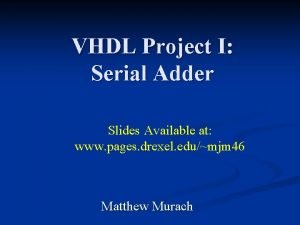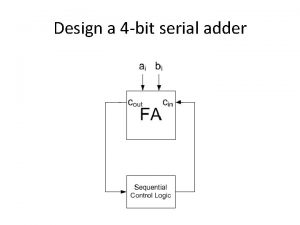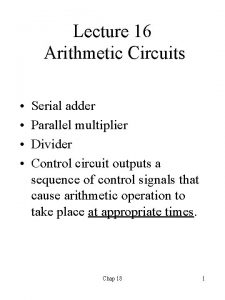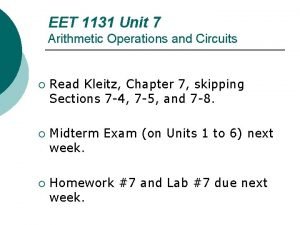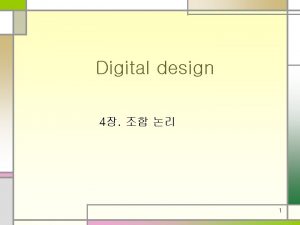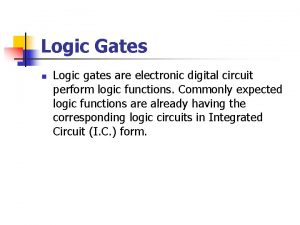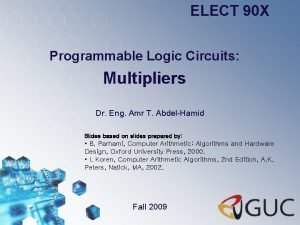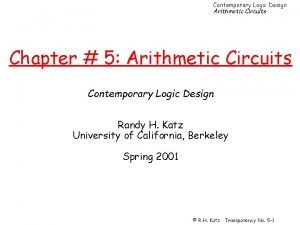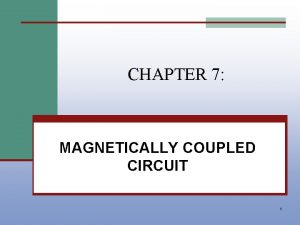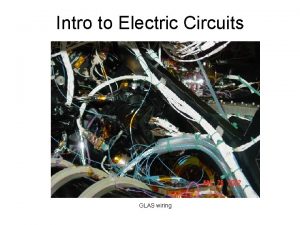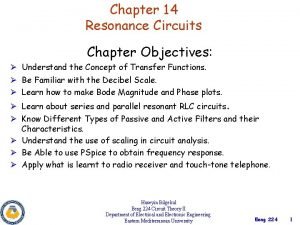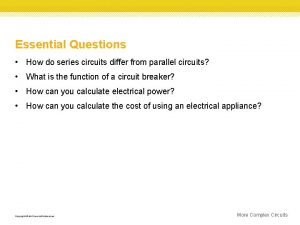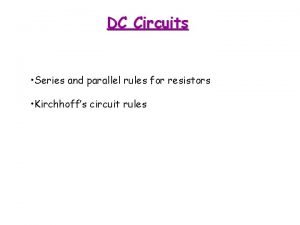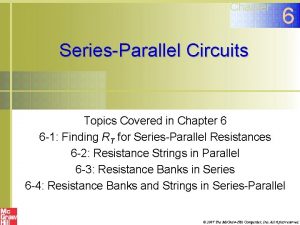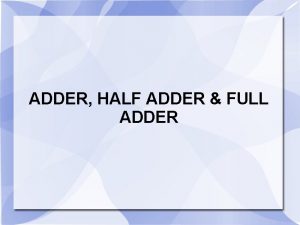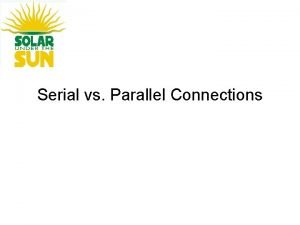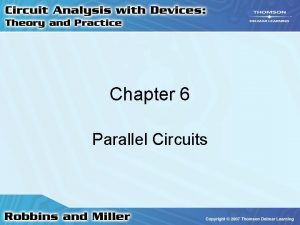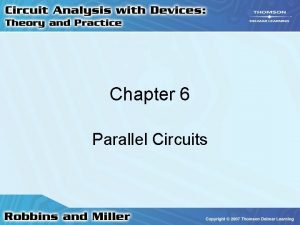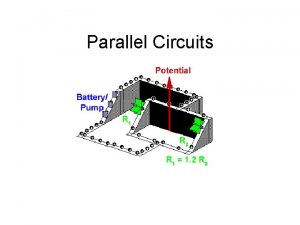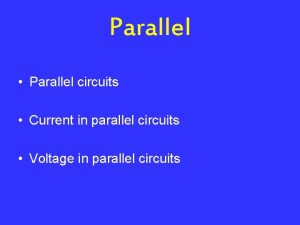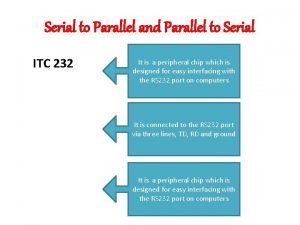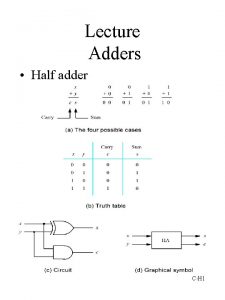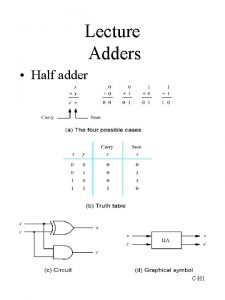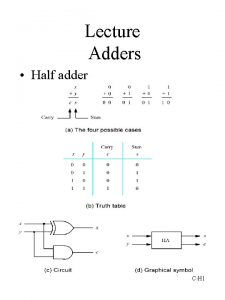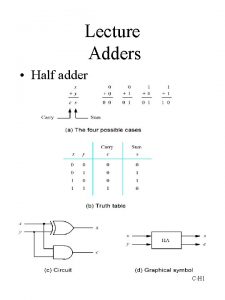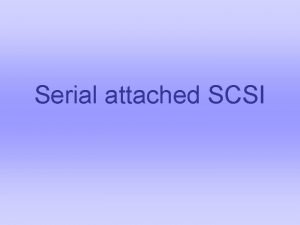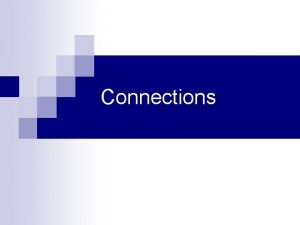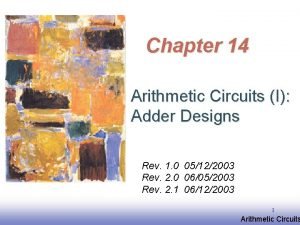Lecture 16 Arithmetic Circuits Serial adder Parallel multiplier







![Multiplier Diagram • • • Product register [3: 0] = multiplier Load: ACC = Multiplier Diagram • • • Product register [3: 0] = multiplier Load: ACC =](https://slidetodoc.com/presentation_image/5c8f2ff3ddc0985cb6caff234fe794a6/image-8.jpg)













- Slides: 21

Lecture 16 Arithmetic Circuits • • Serial adder Parallel multiplier Divider Control circuit outputs a sequence of control signals that cause arithmetic operation to take place at appropriate times. Chap 18 1

Serial Adder • X register – Accumulator: X = X+Y • Y register – Addend register: cyclic shift register • after shifting 4 times, it is back in its original state • Sh: shift signal • SI: serial input Chap 18 2

Serial Adder • At the falling clock edge and Sh= 1 – Si (sum bi) is shifted into x – Carry bit is stored in the D FF. – Register y is rotated one bit to the right. – Initial loading circuit not shown. Sh Carry is only updated when shift. Chap occurs. 18 3

Serial Adder • At the falling clock edge and Sh= 1 s 0, c 1 ready Before the first shift Chap 18 4

Control Unit Realization • A start signal: St. – If St is asserted, then the control unit puts out 4 shift signals then stops. St= Chap 18 5

Serial Processing Unit • A start signal: St. – If St is asserted, then the control unit puts out n shift (Fig. a) St = 1 for only one clock time. – If St remains 1 until the shifting is completed, then a stop state is required. (Fig. b) Chap 18 6

Multiplier • Add shift add…. • Check the right most bit of the multiplier. 1=> add + shift, 0=> shift. Shift right Add Chap 18 7
![Multiplier Diagram Product register 3 0 multiplier Load ACC Multiplier Diagram • • • Product register [3: 0] = multiplier Load: ACC =](https://slidetodoc.com/presentation_image/5c8f2ff3ddc0985cb6caff234fe794a6/image-8.jpg)
Multiplier Diagram • • • Product register [3: 0] = multiplier Load: ACC = 00000: : multiplier Sh: shift ACC 1 bit right. St: start signal, start operation. M bit: M= 1, add + shift. M = 0, shift. Chap 18 8

Multiplier Control • M/Ad: If M = 1 then Ad = 1, the rest of outputs is 0. • How many clocks are required for a multiplication? Reset (waits for start) Chap 18 One bit 9

Multiplier Control • Multiplication for a large number of bits • User a counter. When n-1 shifts have occurred, K = 1. Then go to S 3 for completion (last shift also). Chap 18 10

Division • Division = subtraction and shift • 8 -bit dividend by a 4 -bit divisor to get a 4 bit quotient • Use a 9 -bit dividend register for shifting the dividend left. • Store quotient bit by bit into the dividend register when shifting left. Chap 18 11

Binary Division • Use a 9 -bit dividend register for shifting the dividend left. • Store quotient bit by bit into the dividend register when shifting left. Chap 18 12

Binary Division • Use a 9 -bit dividend register for shifting the dividend left. • Store quotient bit by bit into the dividend register when shifting left. 135 Negative (no sub, shift) After the first Shift. First sub 0 1 0 0 1 1 1 0 0 empty 0 0 1 1 1 0 1 0 0 0 Q 3 1 1 1 1 0 1 Chap 18 13

Binary Division (cont. ) • Use a 9 -bit dividend register for shifting the dividend left. minus 0 0 1 1 1 0 1 Remain 0 bc. minus Then shift left 0 1 1 1 0 0 sub 1 1 0 1 Q 1 =1 bc. sub 0 0 0 Shift Not enough for sub. 1 0 1 1 1 0 0 1 1 0 remainder quotient Chap 18 14

Binary Division (cont. ) • In this example, if Q > 15, then overflow occurs. • If initially X 8 X 7 X 6 X 5 X 4 >= Y 3 Y 2 Y 1 Y 0, then the quotient will be greater than 15 and overflow occurs. • Shift signal: Sh – Shift the dividend one place to the left on the next rising clock edge. • Subtract signal: Su – Use a subtracter to compute X 8 X 7 X 6 X 5 X 4 Y 3 Y 2 Y 1 Y 0 (this is combinational circuit). – Su loads the subtracter output into X 8 X 7 X 6 X 5 X 4 and sets the quotient bit to 1 on the next rising edge. Chap 18 15

Binary Division (cont. ) • Sh: shift the dividend register 1 bit left. • Su: load X 8 to X 4 for the result of subtraction, (Ld). Set X 0 to 1. Chap 18 16

Binary Division (cont. ) • C: if divisor > X 8 to X 4, C=0. No subtraction, generate shift. Sh=1. • Otherwise C =1, subtract signal is generated (Su =1), Q bit is set to 1. Chap 18 17

Binary Division (cont. ) • St: start signal. St =1, load 8 -bit dividend and 4 -bit divisor into registers. If C = 1 at this moment, this is overflow. Set V flag. Chap 18 18

Binary Division (cont. ) • St: start signal. St =1, load 8 -bit dividend and 4 -bit divisor into registers. If C = 1 at this moment, this is overflow. Set V flag. • Normally, C =0 at first. • After C=1 (do sub), then C will always be 0. S 0 S 1 S 2 St Compare and sub, C=0, set Sh =1. St =1. Set Load =1 Final sub Chap 18 19

Binary Division (cont. ) • One-hot assignment Chap 18 20

Binary Division (cont. ) • Complete circuit Chap 18 21
 Advantages of parallel circuit over series circuit
Advantages of parallel circuit over series circuit Vhdl code for serial adder
Vhdl code for serial adder 8 bit serial adder
8 bit serial adder Serial multiplier circuit
Serial multiplier circuit 4bit parallel adder
4bit parallel adder 4 bit parallel adder truth table
4 bit parallel adder truth table Binary addition
Binary addition Bcd adder
Bcd adder Full adder expression for carry
Full adder expression for carry Serial multiplier circuit
Serial multiplier circuit Arithmetic circuits
Arithmetic circuits Magnetically coupled circuits lecture notes
Magnetically coupled circuits lecture notes Bidirectional shift register with parallel load
Bidirectional shift register with parallel load Dramaserial.tv semi
Dramaserial.tv semi 01:640:244 lecture notes - lecture 15: plat, idah, farad
01:640:244 lecture notes - lecture 15: plat, idah, farad Parallel circuit
Parallel circuit Parallel circuits
Parallel circuits Parallel resonance
Parallel resonance Venn diagram series and parallel circuits
Venn diagram series and parallel circuits For protection household circuits contain
For protection household circuits contain Series and parallel circuits rules
Series and parallel circuits rules Solving parallel circuits
Solving parallel circuits

